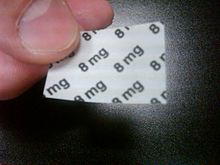Thin-film drug delivery uses a dissolving film or oral drug strip to administer drugs via absorption in the mouth (buccally or sublingually) and/or via the small intestines (enterically). A film is prepared using hydrophilic polymers that rapidly dissolves on the tongue or buccal cavity, delivering the drug to the systemic circulation via dissolution when contact with liquid is made.

Thin-film drug delivery has emerged as an advanced alternative to the traditional tablets, capsules and liquids often associated with prescription and OTC medications. Similar in size, shape and thickness to a postage stamp, thin-film strips are typically designed for oral administration, with the user placing the strip on or under the tongue (sublingual) or along the inside of the cheek (buccal). These drug delivery options allow the medication to bypass the first pass metabolism thereby making the medication more bioavailable.[citation needed] As the strip dissolves, the drug can enter the blood stream enterically, buccally or sublingually. Evaluating the systemic transmucosal drug delivery, the buccal mucosa is the preferred region as compared to the sublingual mucosa.
Different buccal delivery products have been marketed or are proposed for certain diseases like trigeminal neuralgia, Ménière's disease, diabetes, and addiction.[citation needed] There are many commercial non-drug product to use thin films like Mr. Mint and Listerine PocketPaks breath freshening strips. Since then, thin-film products for other breath fresheners, as well as a number of cold, flu, anti-snoring and gastrointestinal medications, have entered the marketplace. There are currently[when?] several projects in development that will deliver prescription drugs using the thin-film dosage form.[1]
Formulation of oral drug strips involves the application of both aesthetic and performance characteristics such as strip-forming polymers, plasticizers, active pharmaceutical ingredient, sweetening agents, saliva stimulating agent, flavoring agents, coloring agents, stabilizing and thickening agents. From the regulatory perspectives, all excipients used in the formulation of oral drug strips should be approved for use in oral pharmaceutical dosage forms.
- ^ "Oral Thin Films," in Orally Disintegrating Tablet and Film Technologies, 5th ed. (Technology Catalysts International, Falls Church, VA, 2008)